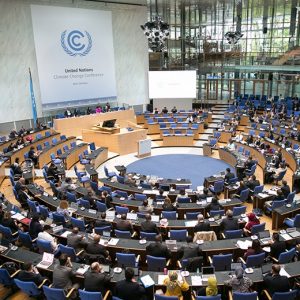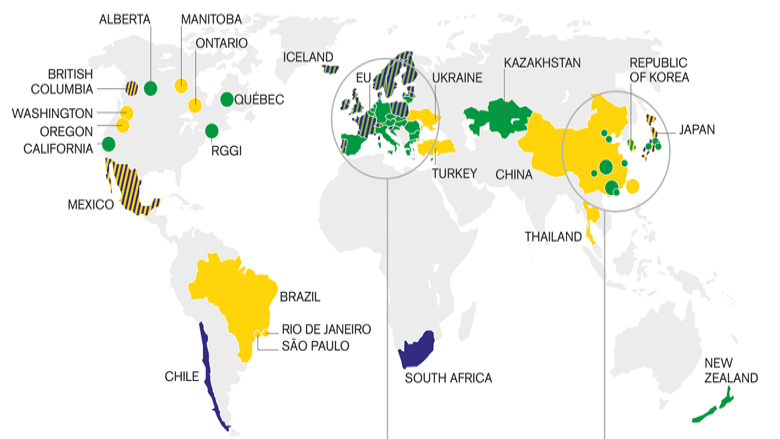In Bonn, Progress On Markets Hampered By Gridlock On Everything Else
Climate negotiators spent the last two weeks in Bonn sketching out the roadmap for achieving the ambitions laid out in Paris. It’s the kind of tedious work that doesn’t generate headlines, but it’s what can be the difference from reaching your destination and ending up in a ditch.

20 November 2017 | The Americas aren’t named for Christopher Columbus, but for his map-maker, Amerigo Vespucci, who first figured out that Brazil is a pretty big part of the New World – something to keep in mind as climate negotiators sketch out the map for implementing the Paris Agreement.
This year’s talks were all about map-making and rules for score-keeping, although in UN-speak they began the “facilitative dialogue” that sets up the “global stocktaking” that underpins the ratcheting process that’s supposed to turbocharge the Paris Agreement, as countries learn from each other to slash emissions faster and faster.
Negotiations around carbon markets only inched forward a bit in Bonn, mostly because agreement is further advanced than in other negotiating tracks, so the financing and adaptation track slowed the markets track – which is a tragedy, because clarity on markets means clarity on finance and adaptation. It was disappointing to see no formal negotiating text emerge, but one is due by March. If you read a piece we posted in January, called “Building On Paris, Countries Assemble The Carbon Markets Of Tomorrow”, you’ll still have a pretty clear idea of where we stand now.
Markets
The Paris agreement doesn’t explicitly mention carbon markets at all, but instead assumes that countries will develop them domestically. The Agreement’s contribution is to recognize this and to say that countries can trade “Internationally Transferred Mitigation Outcomes” (ITMOs) among themselves to deepen the targets they’ve set in their Nationally-Determined Contributions (NDCs).
Article 6 of the Paris Agreement lays out two paths that countries can use to trade their emission-reductions internationally, and the two paths are not mutually exclusive. The first is the “cooperative” approach, which lets countries coordinate trading among themselves, provided they follow accounting principles that pass muster with the UNFCCC.
The second path, championed by Brazil, will be forged within the UNFCCC itself and offer a centralized mechanism for transferring emissions reductions. In Bonn, the Coalition for Rainforest Nations proposed the creation of a second platform, dubbed the “Gateway Mechanism“, but that has not become an official agenda item.

Article 6: Annotated
Here is the full text of Article 6, with brief summaries of each paragraph in simple English.
- Parties recognize that some Parties choose to pursue voluntary cooperation in the implementation of their nationally determined contributions to allow for higher ambition in their mitigation and adaptation actions and to promote sustainable development and environmental integrity.
Countries can cooperate with each other to ramp up their climate change strategies (“allow for higher ambition in their mitigation and adaptation actions”) and promote sustainable development.
- Parties shall, where engaging on a voluntary basis in cooperative approaches that involve the use of internationally transferred mitigation outcomes towards nationally determined contributions, promote sustainable development and ensure environmental integrity and transparency, including in governance, and shall apply robust accounting to ensure, inter alia, the avoidance of double counting, consistent with guidance adopted by the Conference of the Parties serving as the meeting of the Parties to the Paris Agreement.
Countries can meet their emissions reductions targets (“nationally determined contributions”) by trading emissions reductions (“internationally transferred mitigation outcomes”) among each other, and they can create their own governance structures to manage the process, but they must make sure the trading promotes sustainable development, and they must follow accounting principles approved by the UNFCCC.
Questions Raised:
The Paris Accord allows the transfer of emissions reductions between countries, but the national climate strategies are not as uniform as the caps were under the Kyoto Protocol.Interestingly, the Paris Accord does say that trading must promote sustainable development, which seems like a remnant from the days of differentiation.
- The use of internationally transferred mitigation outcomes to achieve nationally determined contributions under this Agreement shall be voluntary and authorized by participating Parties.
No countries are obligated to participate in the carbon markets.
- A mechanism to contribute to the mitigation of greenhouse gas emissions and support sustainable development is hereby established under the authority and guidance of the Conference of the Parties serving as the meeting of the Parties to the Paris Agreement for use by Parties on a voluntary basis. It shall be supervised by a body designated by the Conference of the Parties serving as the meeting of the Parties to the Paris Agreement, and shall aim:
- To promote the mitigation of greenhouse gas emissions while fostering sustainable development;
- To incentivize and facilitate participation in the mitigation of greenhouse gas emissions by public and private entities authorized by a Party;
- To contribute to the reduction of emission levels in the host Party, which will benefit from mitigation activities resulting in emission reductions that can also be used by another Party to fulfil its nationally determined contribution; and
- To deliver an overall mitigation in global emissions.
The UNFCCC will also create a centralized trading platform that countries can use to trade emissions reductions. Some are calling this the “Sustainable Development Mechanism”.
- Emission reductions resulting from the mechanism referred to in paragraph 4 of this Article shall not be used to demonstrate achievement of the host Party’s nationally determined contribution if used by another Party to demonstrate achievement of its nationally determined contribution.
If one country transfers an emissions reduction to another country, then it can no longer deduct those emissions from its own carbon inventory. In other words: no double-counting.
- The Conference of the Parties serving as the meeting of the Parties to the Paris Agreement shall ensure that a share of the proceeds from activities under the mechanism referred to in paragraph 4 of this Article is used to cover administrative expenses as well as to assist developing country Parties that are particularly vulnerable to the adverse effects of climate change to meet the costs of adaptation.
Some of the money raised from the central platform will go to maintaining the mechanism, and some will go to least-developed countries.
- The Conference of the Parties serving as the meeting of the Parties to the Paris Agreement shall adopt rules, modalities and procedures for the mechanism referred to in paragraph 4 of this Article at its first session.
High-level negotiators will provide more details on the Sustainable Development Mechanism at the end of this year in Marrakesh.
- Parties recognize the importance of integrated, holistic and balanced non-market approaches being available to Parties to assist in the implementation of their nationally determined contributions, in the context of sustainable development and poverty eradication, in a coordinated and effective manner, including through, inter alia, mitigation, adaptation, finance, technology transfer and capacity-building, as appropriate. These approaches shall aim to:
- Promote mitigation and adaptation ambition;
- Enhance public and private participation in the implementation of nationally determined contributions; and
- Enable opportunities for coordination across instruments and relevant institutional arrangements.
Countries can also cooperate without using markets, and non-market approaches can be integrated with market-based approaches. Non-market approaches have been promoted by countries such as Bolivia and Venezuela and might include policies to promote renewable energy, as an example.
- A framework for non-market approaches to sustainable development is hereby defined to promote the non-market approaches referred to in paragraph 8 of this Article.
Please see our Reprint Guidelines for details on republishing our articles.

